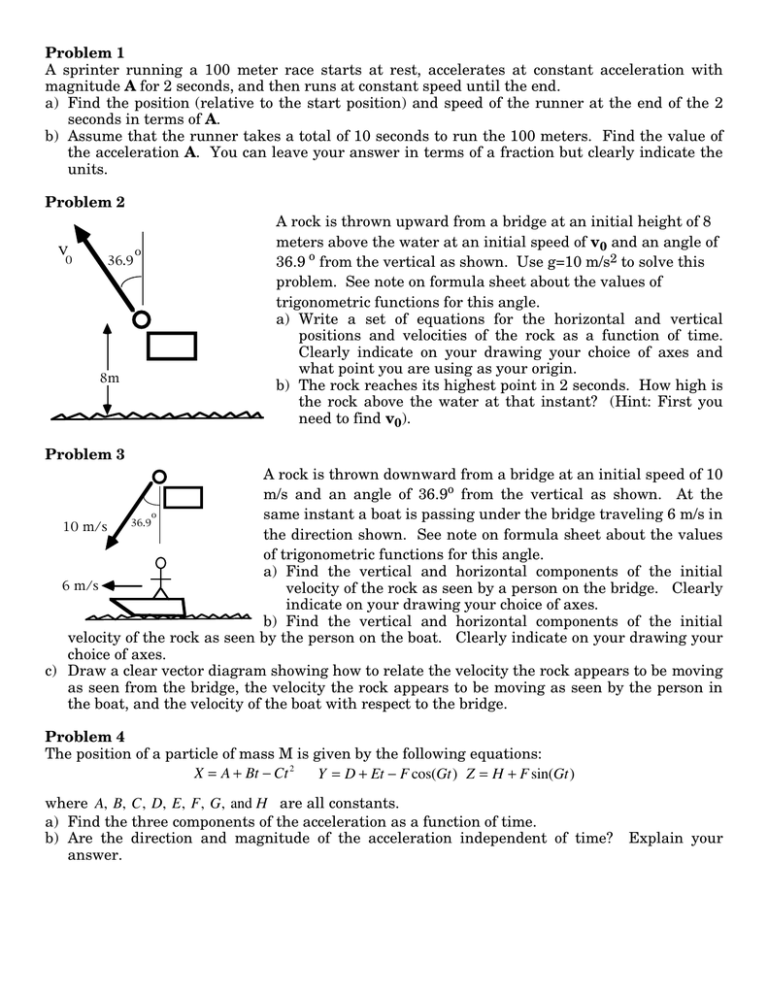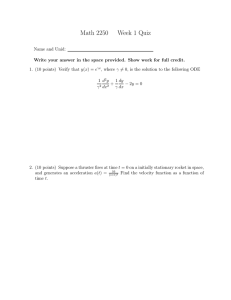Document 13605471
advertisement

Problem 1 A sprinter running a 100 meter race starts at rest, accelerates at constant acceleration with magnitude A for 2 seconds, and then runs at constant speed until the end. a) Find the position (relative to the start position) and speed of the runner at the end of the 2 seconds in terms of A. b) Assume that the runner takes a total of 10 seconds to run the 100 meters. Find the value of the acceleration A. You can leave your answer in terms of a fraction but clearly indicate the units. Problem 2 v 0 36.9 8m o A rock is thrown upward from a bridge at an initial height of 8 meters above the water at an initial speed of v0 and an angle of 36.9 o from the vertical as shown. Use g=10 m/s2 to solve this problem. See note on formula sheet about the values of trigonometric functions for this angle. a) Write a set of equations for the horizontal and vertical positions and velocities of the rock as a function of time. Clearly indicate on your drawing your choice of axes and what point you are using as your origin. b) The rock reaches its highest point in 2 seconds. How high is the rock above the water at that instant? (Hint: First you need to find v0). Problem 3 A rock is thrown downward from a bridge at an initial speed of 10 m/s and an angle of 36.9o from the vertical as shown. At the o same instant a boat is passing under the bridge traveling 6 m/s in 36.9 10 m/s the direction shown. See note on formula sheet about the values of trigonometric functions for this angle. a) Find the vertical and horizontal components of the initial 6 m/s velocity of the rock as seen by a person on the bridge. Clearly indicate on your drawing your choice of axes. b) Find the vertical and horizontal components of the initial velocity of the rock as seen by the person on the boat. Clearly indicate on your drawing your choice of axes. c) Draw a clear vector diagram showing how to relate the velocity the rock appears to be moving as seen from the bridge, the velocity the rock appears to be moving as seen by the person in the boat, and the velocity of the boat with respect to the bridge. Problem 4 The position of a particle of mass M is given by the following equations: X = A + Bt Ct 2 Y = D + Et F cos(Gt ) Z = H + F sin(Gt ) where A, B, C, D, E, F, G, and H are all constants. a) Find the three components of the acceleration as a function of time. b) Are the direction and magnitude of the acceleration independent of time? answer. Explain your Problem 5 F F F An object is acted on by three forces. All three forces have exactly the same magnitude. Two of the forces are perpendicular and the third acts at an angle as shown above. No other forces act on this object. Which of the following is true? For full credit, explain your answer. 1) It is possible for this particle to remain at rest. 2) It is not possible for this particle to remain at rest. 3) You cannot answer this question without knowing the value of the angle . 4) You cannot answer this question without knowing both the value of the angle and the magnitude of the forces F. Problem 6 A person pulls on a block by applying a force F and the block remains at rest. The arrows in the diagram correctly show the directions, but not necessarily the magnitudes, of the various forces on the block. Which of the following relations among the force magnitudes F, W, N, f must be true? f is friction and W is the weight (the force of gravity). F = f and N = W F = f and N > W F > f and N < W F > f and N = W None of the above choices is correct. Problem 7 The position of a particle is given by the following equations: x = at + bt 3 where a = 2.0 m s and b = 0.5 m F W f N s3 rad s 2 a) Write equations for the components of the velocity, vx and vy, as functions of time. b) Write equations for the components of the acceleration, ax and ay, as functions of time. c) Make an XY plot showing (as dots numbered 0 and 1) the position of the particle at t=0 and 1 seconds. On this same plot, draw two arrows at each dot showing the approximate direction of the velocity and acceleration at that time. If either velocity or acceleration has zero magnitude, indicate that clearly. Label your two arrows so we know which is which. Don't worry about the length of these arrows, just their approximate directions y = A sin(Bt ) where A = 2.0m and B = Problem 8 While driving along the highway at 40 m/s, you spot a police car 50 m ahead, traveling at a constant speed of 30 m/s which is the speed limit. You apply the brakes and begin decelerating at 1.0 m/s2. Assume that the police officer will give you a speeding ticket only if you pass her car. Will you get a ticket? Justify your answer numerically. [Hint: You can solve this problem by trying to solve a quadratic equation; look closely at the numbers! Instead, you might want to think about when the cars have equal velocities.] Problem 9 A rocket, initially at rest on the ground, accelerates straight upward with constant net acceleration, B, from time t=0 until t=T1, at which time the fuel is exhausted. Neglect air resistance and assume that the rocket stays close enough to the ground that the acceleration due to gravity (after the rocket engine stops) is given by g. a) Find the maximum height, H, that the rocket reaches above the ground. b) If the rocket's net acceleration, B, is equal to 1.0g, find an expression for the total time, Tmax, that the rocket is in the air (i.e. from liftoff until it hits the ground) in terms of T1. You do not need to solve your expression numerically but simplify it as much as possible. Problem 10 You are standing on the Mass Avenue Bridge watching the boats on the Charles. You see a motorboat pass directly below you, traveling perpendicular to the bridge at a speed of 6 m/s. A person on the boat throws a baseball at an initial speed of v0 and at an angle of 36.9o from the vertical (Note: both v0 and the angle are with respect to the boat). Find the value of v0 necessary for the ball to travel straight up towards you. Show clearly on the drawing the direction the ball is thrown relative to the boat. 6 m/s Problem 11 A circus acrobat is launched by a catapult at a speed of 15 m s at an angle of = 40° above the horizontal as shown. At a distance of 20 m away, her partner is standing on a platform at a height of h meters. At the instant that the acrobat is launched, her partner throws a basketball towards her horizontally at a speed of 5 m s . Ignore air resistance in solving this problem. a) Write equations for the horizontal and vertical positions as functions of time for both the acrobat and the basketball. Be consistent in your choice of origin. b) When will the performer and basketball be at the same horizontal position? c) Find the value of h for which the acrobat will catch the ball. Assume that she and the ball must be at the same height for her to catch it. d) Find the magnitude of the velocity of the ball relative to the acrobat at the instant that she catches it. Problem 12 Young & Freedman 5.11 and 5.12 on page 194. 20 m 5 m/s h 15 m/s


